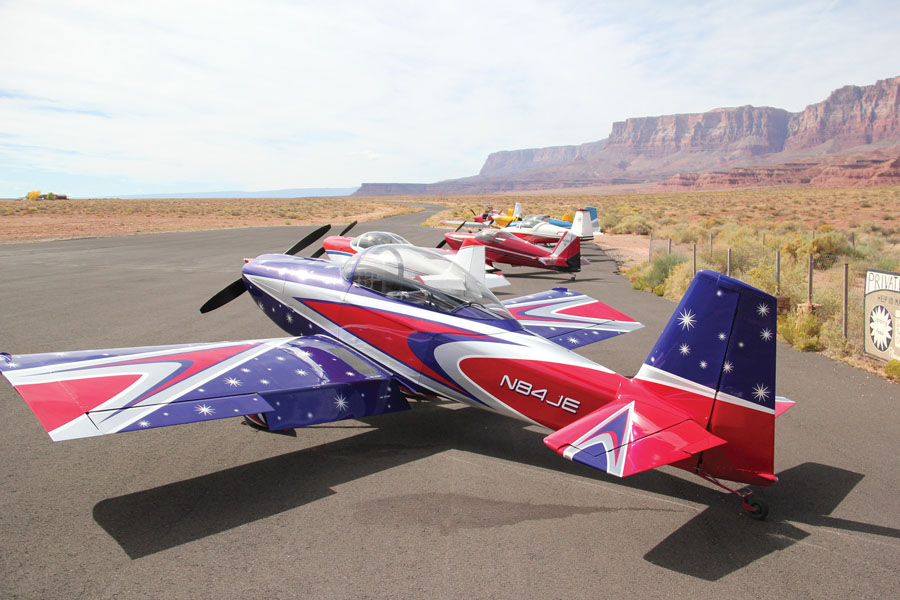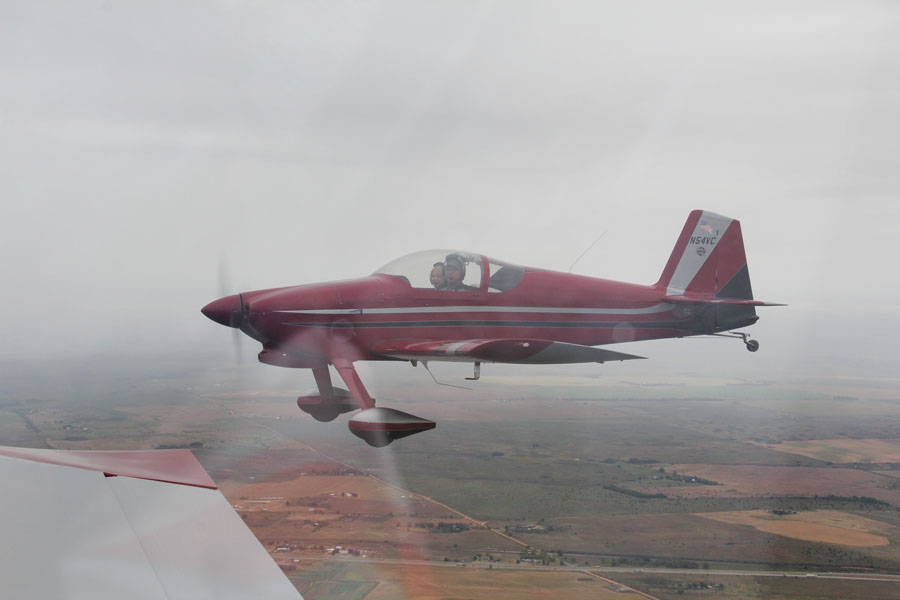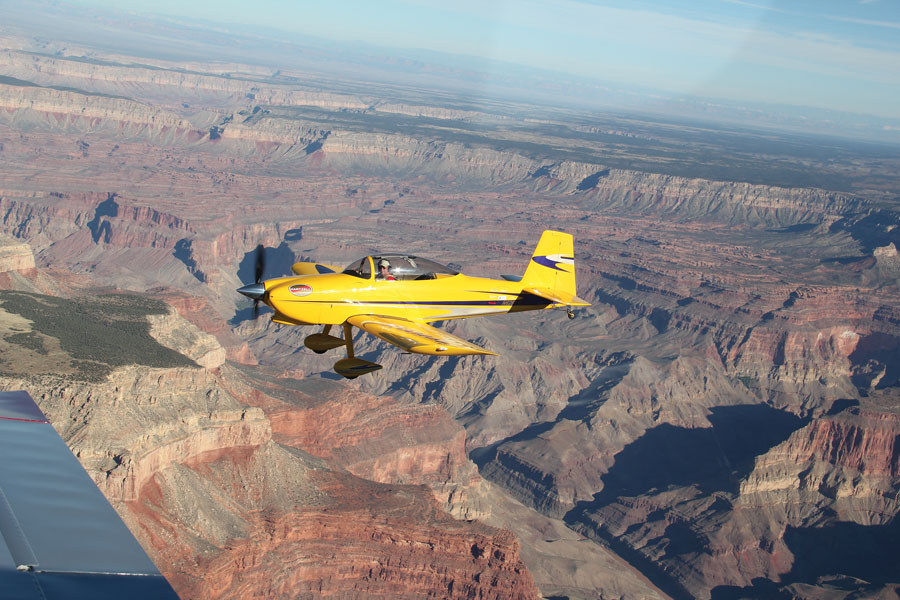
Staged for takeoff at Marble Canyon. Takeoff spacing should be pre-briefed and adhered to, which will ensure proper flight spacing. Ten seconds is a good rule of thumb to start with.
I know I’ve been writing a lot about inspections and maintenance, so this month I’ll shift gears and share some thoughts on one of the fun sides of flying—taking group trips in your airplanes. My focus is going to be on a vacation-like trip, not the typical Saturday morning fly-out to breakfast or lunch. Over the years we have had some really memorable trips, and I continue to learn how to get the most pleasure out of them, both as a leader of the flights and as a participant. As a matter of fact, we just returned from a week-long trip from Atlanta to Arizona with a group of 10 RVs from the Falcon Squadron at KFFC, and it was such a blast it prompted me into thinking I should write a column about group flyouts.

On long cross-country VFR flights, there is certainly the potential to run into low-visibility situations, either from precip or smoke. Pre-launch briefings should be very concise regarding the planned actions. Having formation experience adds a level of safety for both lead and wingmen to close the in-flight separation if needed.
Initial Planning
Sometimes a group trip has its beginnings because someone makes a comment about the beautiful scenery they saw on a particular trip, and it gets others interested in going. Other times, someone mentions that they have a particular destination in mind, and pretty soon others want to go there, too. Whatever the reason, a major factor is to start planning the trip well in advance of the departure date. My recommendation is that the planning should start at least three to five months ahead of the targeted date for in-country trips, and even a year or two in advance for more exotic destinations like Alaska or other continents. Once you understand all of the planning that needs to take place to ensure a smooth and enjoyable trip, you will understand why.
Some of the first discussions should gain agreement on the length of the trip, the destinations, and the potential costs. For the long cross-country trips, multiple routings should be discussed in case of weather impacts. I will tell that after traveling four or five days to get somewhere, there is nothing worse than hearing someone expressing a desire to get home sooner than planned. It gets uncomfortable for everyone, and with changes in the weather it can sometimes back the group into a bad decision-making corner. I have found that by having alternate planned routes and making hotel reservations that allow same-day cancellation, decision-making usually takes a better turn. Hotel reservations are another reason you want to start planning far in advance when traveling with a group, especially if you all want to stay close together and are traveling to seasonal destinations. Sometimes you can negotiate group rates. Delays due to weather can have a major impact upon the cost of the trip, so be prepared to incur extra costs, but also have the frame of mind to spend some time enjoying the sights on the ground. On one trip to Alaska I met a VFR pilot at Yakutat (middle of nowhere) flying a C-182 who said he had been grounded for a week. I think I said “bummer” and he replied, “Are you kidding? This is some of the best fishing in the world!” My hat was off to him for enjoying the delay.

If you are constantly seeing the airplane in front of you this size, then you are too close. The flight will get tiring, and you will miss the scenery.
Trip and Aircraft Preparation
Once the length and cost discussions are out of the way, you will have a good idea of the committed participants. Now is a good time to assign some responsibilities, such as flight planning, hotel reservations, Customs information (if needed), survival gear recommendations, etc., and set a timeline and mechanism for group updates. It is now a time also for the pilots and aircraft owners to start thinking about a maintenance schedule that will have their airplane in top shape at least one week prior to departure date. Why one week? Two reasons: One, if you wait until that last week to get everything completed, there’s a chance you might need a part that won’t arrive in time. Who hasn’t broken something while they were fixing something? And two, there’s no way I am going to button up an aircraft and fly it on a long trip after maintenance without a couple of prior test hops. This is also one area where having someone else look over your engine compartment is a good idea. Other people tend to tug and pull on things or ask questions that the owner sometimes misses. On our most recent trip we had one in-flight alternator failure due to a loose connection at the main alternator lead, and one dead battery on the morning of departure. It was clear that the alternator lead had been arcing for a while, and the battery was over five years old. Sure, we all hear that the batteries can last longer, but why chance it on a long trip? The delays and costs on the road usually far exceed the costs at home. Take the same approach with other life-limited components, such as 500-hour magneto service bulletins or spark plugs that could be reaching end of life. A screwdriver, socket, or wrench should be put on every fitting in the engine compartment and checked for proper torque and security. On some of the trips that happen to have the best scenery in the most desolate places, you will be glad you did!

The use of ADS-B can help to see the flight separation. As most of the time everyone’s transponders will be off except for lead and trail, this check needs to be coordinated by lead.
And if per chance one aircraft does have an in-flight problem, it is best if the flight continues on while only one of the other members accompanies the stricken aircraft.
Be sure to take copies of all of your pilot certificates, medical certificates, and insurance information. Unfortunately, these critical items can get lost or stolen while on trips, and you need them, especially if you are going through Customs.
A couple of important group decisions need to be discussed prior to leaving and they are related to comfort. After all, this is a vacation, right, and most likely everyone in the group is not comfortable with your typical bladder-busting flight legs. Find out who is the limiting factor and work around it. Usually 2- or 2 -hour legs are good enough to cover some serious territory and still have everyone refreshed and in a good mood upon arrival. Then, find out who has the slowest cruising speed. During these preparatory months everyone should go fly their airplane and perform the GPS triangle airspeed/groundspeed exercise so each pilot knows what, if any, errors are in the airspeed indicating system. More about that later.
During some of the discussions it should be decided how the group will be divided and who the lead pilots will be. The trip organizer is not necessarily the flight leader. That should be given to someone who perhaps has experience in leading, does great flight planning, and is comfortable on the radio talking to ATC when necessary. If the group is large, say 10 or more, then dividing the group up into smaller flights of three to five, with a couple of minutes on the departure spacing, can work real well.

Your friends will appreciate the wonderful in-flight photos taken over some of the finest scenery of the trip. Again, these photo sessions should be clearly briefed on the ground, and only one airplane should be moving around while one holds straight and level (and watches for traffic!).
Flight Considerations
So, let’s talk about the flying aspect of the trip. There are many ways to tackle this one. Everyone can agree to meet at certain points and times, traveling separately. Sometimes this can be the most enjoyable way for some pilots, and in particular a family member who doesn’t like traveling in close proximity to other aircraft. Notice I said “close proximity.” There is nothing about this trip that should resemble a formation flight. At best, each aircraft should be trailing the prior aircraft by to mile and offset on a 45-degree angle. With this spacing, every airplane should be visible to at least two to four other airplanes in normal visibility conditions. It is important to remember that we are here to enjoy the trip and to sightsee along the way—not practice our formation skills.
There are two speeds that need to be discussed with the group—climb speeds and cruise speeds. Some of the fixed-pitch aircraft actually have to climb faster in order to cool properly, so discuss that ahead of time and lead will have to adjust accordingly. So how do we determine the flight speed? Hopefully the group doesn’t have too large of a disparity, such as having Lancairs and Kitfoxes in the same flight. But even with a group of RVs, some with fixed-pitched props and some with constant-speed props, there will be enough of a disparity that it needs to be understood.
Here is a good rule: The cruising speed of the flight should be 10 to 20 knots lower than the normal cruising speed of the slowest airplane. It is important that the lead aircraft set this speed and maintain it. The 10- to 20-knot buffer allows for each of the other aircraft to have some available power for adjusting position as the flight progresses.
The second good rule to follow is to have lead call out his/her groundspeed once established in cruise. Then, if everyone in trail aims for the same groundspeed, the flight has a really good chance of maintaining separation and proper spacing without a lot of rubber-banding. From experience I will tell you that having everyone aim for the same indicated airspeed does not work. On our last trip we had agreed on 160 knots TAS, and one pilot said he was running really hard to keep up and was showing 170 knots. I asked everyone in the flight for their groundspeeds, and they all matched, including his. Clearly he had a static leak and it was reflected in a higher-than-normal indicated airspeed. He really wasn’t going any faster, and I think we debunked how fast his RV supposedly was! Again, don’t try to keep the group together by using airspeeds.

A sign of a respected leader for sure! In this case it was Greg Reese from Falcon Field in Peachtree City, Georgia, who led our group to Arizona. Greg was also a member of Team Aerodynamix for many years and has lots of experience with group flying. Here is the group gathered around Greg’s RV-8 at Monument Valley.
Talking to ATC
While it is possible to travel all the way across the U.S. without talking to anyone, in today’s crowded airspace and with the propensity for TFRs to pop up, I find it a good practice to stay in contact with ATC, letting them know we have a flight of aircraft. Depending upon the size of the flight, usually only lead will squawk, but if the flight is larger, ATC will sometimes have the trail airplane squawk as well. And of course if transitioning the ADIZ in the U.S., everyone has to have a discreet code. An appropriate air-to-air frequency for the flight should be agreed upon as well.

You can’t fly all of the time, although some of us wish we could. Taking in the local sights gives everyone a chance to visit, as well as share the excitement they are having on the adventure.
When approaching the destination airport it is a good idea to tighten up the flight a little if possible, although it should still not be in a close formation (unless, of course, all of you are formation qualified and used to flying with each other). Let ATC know you are a flight and they will usually provide spacing for you to remain together. My preference is to use the proper traffic patterns at uncontrolled fields, rather than trying to do overhead breaks. There are still lots of NORDO airplanes out there, and chances are they are looking for traffic in the normal pattern.

If you have 100% participation for breakfast fly-outs on day four, it must be working right! Here was our RV group at Monument Valley. The scenery and the smiles were hard to beat.
After one or two legs on the trip, you will soon find out who is comfortable or not comfortable in their current positions, so don’t hesitate to make adjustments. Again, this is supposed to be a fun trip, and it should be as much about the flying as it is about the destination. And the only admonition I have is to pay attention at the final shutdown of each day. It is very easy to get caught up in the excitement of the arrival, neglecting a good shutdown checklist, only to discover the next morning that you left the master switch on and now have a dead battery. It can put a damper on the fun factor.
Enjoy your trip!














